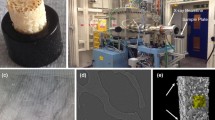Abstract
X-ray microtomography (μCT) is a popular tool for imaging scaffolds designed for tissue engineering applications. The ability of synchrotron μCT to monitor tissue response and changes in a bioactive glass scaffold ex vivo were assessed. It was possible to observe the morphology of the bone; soft tissue ingrowth and the calcium distribution within the scaffold. A second aim was to use two newly developed compression rigs, one designed for use inside a laboratory based μCT machine for continual monitoring of the pore structure and crack formation and another designed for use in the synchrotron facility. Both rigs allowed imaging of the failure mechanism while obtaining stress–strain data. Failure mechanisms of the bioactive glass scaffolds were found not to follow classical predictions for the failure of brittle foams. Compression strengths were found to be 4.5–6 MPa while maintaining an interconnected pore network suitable for tissue engineering applications.





Similar content being viewed by others
References
Langer R, Vacanti JP. Tissue engineering. Science. 1993;260:920–6.
Takezawa T. A strategy for the development of tissue engineering scaffolds that regulate cell behavior. Biomaterials. 2003;24:2267–75.
Ohgushi H, Caplan AI. Stem cell technology and bioceramics: from cell to gene engineering. J Biomed Mater Res. 1999;48:913–27.
Jones JR, Ehrenfried LM, Hench LL. Optimising bioactive glass scaffolds for bone tissue engineering. Biomaterials. 2006;27:964–73.
Hulbert SF, Morrison SJ, Klawitte JJ. Tissue reaction to three ceramics of porous and non-porous structures. J Biomed Mater Res. 1972;6:347–74.
Yang S, Leong KF, Du Z, Chua CK. The design of scaffolds for use in tissue engineering. Part I. Traditional factors. Tissue Eng. 2001;7:679–89.
Sepulveda P, Jones JR, Hench LL. Bioactive sol–gel foams for tissue repair. J Biomed Mater Res. 2002;59:340–8.
Xynos ID, Edgar AJ, Buttery LDK, Hench LL, Polak JM. Gene-expression profiling of human osteoblasts following treatment with the ionic products of Bioglass (R) 45S5 dissolution. J Biomed Mater Res. 2001;55:151–7.
Hench LL, Polak JM. Third-generation biomedical materials. Science. 2002;295:1014–7.
Jones JR, Poologasundarampillai G, Atwood RC, Bernard D, Lee PD. Non-destructive quantitative 3D analysis for the optimisation of tissue scaffolds. Biomaterials. 2007;28:1404–13.
Stock SR. X-ray microtomography of materials. Int Mater Rev. 1999;44:141–64.
Atwood RC, Jones JR, Lee PD, Hench LL. Analysis of pore interconnectivity in bioactive glass foams using X-ray microtomography. Scripta Mater. 2004;51:1029–33.
Konerding MA. Scanning electron-microscopy of corrosion casting in medicine. Scanning Microsc. 1991;5:851–65.
Ibanez L, Schroeder W, Ng L, Cates J. The ITK software guide. Clifton Park, NY: Kitware Inc.; 2003.
Mangan AP, Whitaker RT. Partitioning 3D surface meshes using watershed segmentation. IEEE Trans Vis Comp Graph. 1999;5:308–21.
Lin S, Ionescu C, Pike KJ, Smith ME, Jones JR. Nanostructure evolution and calcium distribution in sol–gel derived bioactive glass. J Mater Chem. 2009;19:1276–82.
Gibson LJ, Ashby MF. Cellular solids structure and properties. Oxford: Pergamon Press; 1988.
Acknowledgements
Julian Jones is a Royal Academy of Engineering/Engineering and Physical Science Research Council (EPSRC) Research Fellow. The authors also acknowledge financial support from the Philip Leverhulme Prize and EPSRC (GR/T26344). The European Synchrotron Radiation Facility especially the team of beam line ID19, especially Elodie Boller is greatly acknowledged for the provision of synchrotron radiation facilities.
Author information
Authors and Affiliations
Corresponding author
Rights and permissions
About this article
Cite this article
Yue, S., Lee, P.D., Poologasundarampillai, G. et al. Synchrotron X-ray microtomography for assessment of bone tissue scaffolds. J Mater Sci: Mater Med 21, 847–853 (2010). https://doi.org/10.1007/s10856-009-3888-9
Received:
Accepted:
Published:
Issue Date:
DOI: https://doi.org/10.1007/s10856-009-3888-9




